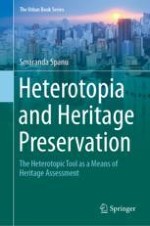Abstract
One of heterotopia’s main interpretation directions in the examined specific literature points towards the function of the object—term understood as the binomial pairing of architectural programme and the associated characteristic practices. This direction is first justified through the very structure of the referenced Foucauldian text (Of Other Spaces) which offers one such architectural programme as exemplification of each heterotopic principle, be it the binomial pairing of object plus practices (cemetery) or space plus practices (the festival, the colony); each of these palpable examples or programmes addressed in the philosophers text are read within their context (historic, social, political, geographic, etc.) appearing as mechanisms created by and for its functioning and necessities. This chapter explores this direction following the six-principle structure described by Foucault and their more prominent function-focused interpretations (Dehaene, De Cauter, Cenzatti, Petterson, etc.). The main profiles defined by Foucault—the crisis space, the space of compensation, of illusion, etc.—as well as the ‘secondary’ interpretations—defining it as tertiary space, intermediate space, public–private hybrid or space of mediation—are discussed from the perspective of the functions of the space, the architectural programme, but also in their redefined instances as heritage spaces. The generalization of the heterotopic character for an entire functional category (or architectural programme) can lead to an excessive abstraction and equivocal interpretation, hiding the individuality of the single object and finally downgrading the concept. At a quick glance, several common heterotopic traits can be identified for each functional category (such as cemeteries, prisons); despite these, upon covering the various approaches found in the specialized literature, it has been observed that the structure of the physical space and the functional structure can indeed possess a heterotopic potential, more or less intense or manifest, but not necessarily an all-encompassing heterotopic character. As shown in the previous chapter, focused on utopias, the consideration of any embodiment and evolution of these utopias as a heterotopic space would reflect a superficial approach of the concept, as well as a devaluation of the complexity of its significations. A favourable valorization of the concept would be, as considered throughout this research, the pursuing of the heterotopic characteristics not only within the functional categories (where they manifest and can be observed as physical traits) but also as practices and as contextual relations—both spatial and temporal. As this research argues, the category can retain, and usually does, this heterotopic predisposition, or heterotopic potential, that can become “active” on an ‘object to object basis’, through the manifestation of specific practices and through its particular relationing to its spatial and temporal context. Thereby, this chapter argues that the interpretation of the heterotopic space must rely on both an analysis of functionality/architectural programme (the material) and an analysis of the practices that have generated it (historical practices) and that inhabit it (present practices) as well as an analysis of its internal and contextual relations.
